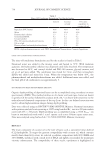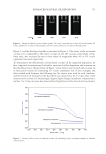737 ENHANCED NATURAL OIL DEPOSITION on the surface of the hair, presumably from the shampoo washing after the oil treatment. Under this layer there is a mixed layer that starts out richer in coconut oil and decreases toward the hair surface, where the concentration of methacrylate copolymer increases. This may describe a deposition mechanism where the copolymer acts somewhat as a primer, and this helps the coconut oil adhere to the hair, much like a primer helps paint stick to wood. As the copolymer is uniformly dispersed within the coconut oil, it is also possible that the smaller, more mobile coconut oil migrates toward the air interface and the copolymer stays localized closer to the hair fiber. CN is likely from proteins in hair or other organic nitrogen compounds, not necessarily from cyanide. At the deepest part of the profile toward the right, CN has a high concentration as the hair is etched. At the air interface, it is also richer, although the compounds that cause this enhancement are unclear. 1.0 0.9 0.8 0.7 0.6 0.5 0.4 0.3 0.2 0.1 0.0 Sputter Time [s] 60 40 20 0 Figure 6. Negative ion depth profile from the top hair from Figure 5. Green circles are CN, red plus signs are coconut oil, pink x’s are lauryl sulfate, and blue asterisks are methacrylic ions. Data are normalized to the maximum signal for each ion. oMaxmum Nomazed
738 JOURNAL OF COSMETIC SCIENCE DISCUSSION Through this work we have demonstrated that acrylic copolymer structured coconut oil is retained on the hair surface after washing at a higher level. Additionally, through SIMS we have shown that the structured oil is uniformly distributed over the hair fiber, providing a nice even coating. We next sought to understand the impact of this oil deposition on consumer perceivable benefits like combing, reduced friction, and improved feel of the hair. In this section we will describe two pieces of work: first, coconut oil leave-in treatments that are then washed with shampoo to reduce the greasy haptics and second, the incorporation of these structured coconut oils in standard rinse-off conditioner applications. LEAVE-IN COCONUT OIL TREATMENTS In these experiments, coconut oil or structured coconut oil are used as leave-in conditioner treatments that are then washed off with shampoo. This is a common practice in India and the Middle East where coconut oil would be massaged into the hair before bed and washed the following morning. In Figure 7, the results show that coconut oil structured with acrylic copo- lymers provided an improvement in the reduction in dry combing force compared to the control formulation (coconut oil only) without such polymers. This impact was observed at copolymer use levels as low as 0.5% in the formulation despite having no impact on the viscosity at this use level. It was noted that when the acrylic copolymer was used at 6% in the structured oil gels that the retention on the surface was significant and negatively impacted the haptics of the hair tress. Given this behavior and the data in Figure 7, we hypothesize that there is optimal per- formance when the oil is slightly structured but not overly gelled in these leave-in treatments. RINSE-OFF CONDITIONER TREATMENTS After having demonstrated the utility of these structured oils, we explored if these benefits could be observed from rinse-off conditioners that contained coconut oil. While direct Figure 7. Average dry combing force on 8 hr bleached hair tresses after treatment with structured or unstructured coconut oil followed by shampooing. The control is coconut oil only.
Purchased for the exclusive use of nofirst nolast (unknown) From: SCC Media Library & Resource Center (library.scconline.org)






































































































































